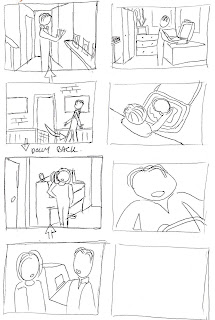 By Dan Parkes (Director)
By Dan Parkes (Director)Especially thanks to detailed Making Of books and behind-the-scenes extras on DVDs, the art of storyboarding has become more popular in recent times, emphasised by the increase in elaborate actions sequences and CG effects.
However storyboards are not only for effects shots. We created some simple storyboards to work out scenes where blocking may become complicated due to the number of cast members or due to the logistics of shooting in a particular location.
Here are a few things to think about when it comes to storyboarding:
- Storyboards are primarily designed to indicate character blocking, camera framing and angles, camera movement and edit cut points.
- Storyboards are great for breaking a scene down into a series of shots-wide, mediums and close ups.
- You can use them to calculate how many shots you can get from a particular angle.
- They can be used to create a comprehensive shot list (it’s good to include the storyboard in the shot lists used on set) that you can show crew on set.
- It is best to avoid letting actors see the storyboards, as it may cause them to perform unnaturally.
- Do not start storyboarding until a location has been chosen, otherwise you may find yourself storyboarding something that is impossible to shoot.
- Base storyboards on location drawings, photographs and floor plans.
- Storyboards read vertically, rather than horizontally, as is traditional with cartoon strips.
- They do not need to be elaborate art works; stick figures are just as useful.
- Don’t over storyboard –just key or difficult shots or scenes.
- You can even edit storyboard shots together with sound and music to simulate the finished piece and to establish pace; this is called “pre-viz” and can be done using computer software.






No comments:
Post a Comment